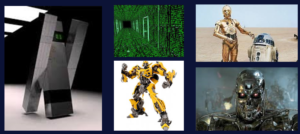No products in the cart.
Artificial Intelligence for Children – Part I
When you hear about Artificial Intelligence and Machine Learning, what do you think? Do you think of a future where robots will be doing all the work, or supercomputers that are more intelligent than humans and machines that will someday take over the world? Well, these things might happen, but these ideas are still in the realm of fiction and movies.
However, Artificial Intelligence is real and is not a futuristic idea. There are lot of things that are happening in the AI space and they are all impacting us already. When you shop on an e-commerce platform like Amazon or watch a movie on Netflix or even search for anything on Google, AI is helping you in the background.
You want to know what is AI and how it is impacting our lives?
Let us see how AI has evolved. We will go back into history a little to put it all into perspective.
Let’s begin with machines. What are machines? Humans have always tried to make their lives easy. The early man made a wheel and it helped by reducing the effort against friction. Simple machines that we see around us are knives, screw drivers, thermometers and there are complex machines such as cars, aeroplanes, MRI machines and televisions. Machines help humans in so many ways to make life easy.
Then came computers. Computers, as the name suggest, were computing machines initially. They could make calculations faster, make repetitive calculations quicker and without mistakes.
Well, I have shown your smartphones and smartwatches in the above image along side the big, bulky desktops and laptops. This is not by mistake – your handheld and wearable devices are all mini-computers and most of them have lot more computing power than what was available to NASA scientists for sending the first person into space in 1969.
You must be wondering that how could faster calculations make computers do all that they do today. So, let’s take a peep inside these machines to get an idea.
What happens is that, unlike humans, who think of numbers in the base 10 (i.e. all the numbers that we can think of can be represented using 10 digits, from 0-9), computers process information in base 2 or in binary form i.e. 0 and 1. This could look like a limitation but it actually helped structure information using simple electric switches that could be either ‘on’ or ‘off’ i.e. behave like binary logic.
This representation of information in binary form began the phase of ‘digitalization’. Computer Scientists and Mathematicians started converting whatever they could convert to binary digits. For example, the photos that were earlier taken on camera reels and printed on photo paper were sliced into small squares (called pixels) and each square was shown as either 0 or 1 depending on the light intensity in that square. Gradually, the number of squares in which an image could be cut increased (even simple smartphones today cut each picture in 10-12 Megapixels or 10 – 12,000,000 small squares). With such fine breaking of image, human eye does not find the image “pixelated” and it is an experience nearly as good as the old, paper process. Just to add here, that this explanation makes sense to create a black-and-white photograph but for a color photo, each pixel was further divided into 3 binary numbers – for Red, Green and Blue hues – and the combination of information could help create a color photograph.
As the number of applications using computers exploded, the next big thing in this journey was already at the doorstep – the Internet.
The movement of information between computers was easy as only binary data was to be transported from one place to other – which would be equivalent of sending out signals that were on or off.
Internet started changing everything. Information was easy to get. We could communicate with anyone around the globe quickly and easily. We started shopping, making video calls and watching TV over DTH (Direct-to-Home) services or Cable services. Imagine all this through 0’s and 1’s moving at ever increasing speeds around the world!
So, where is Artificial Intelligence in this story? Did I lose the trail and drifted into another direction? Well, no. I just wanted you to get a feel of how AI came into play.
However, while you are excited and want me to start talking about AI, like in a TV series, let’s take a pause at a crucial part of our story and we will continue from here in our next article.
For Science videos : https://www.youtube.com/c/ExperiHub
Tags: Artificial Intelligence


